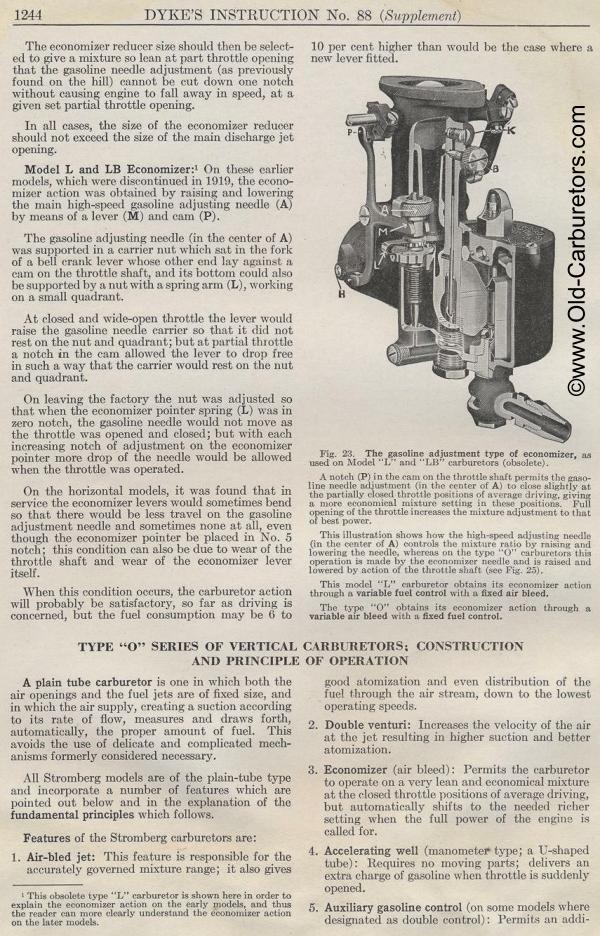Stromberg
DYKE'S INSTRUCTION No. 88 (supplement)
The economizer reducer size should then be selected to give a
mixture so lean at part throttle opening that the gasoline
needle adjustment (as previously found on the hill) cannot
be cut down one notch without causing engine to fall away in
speed, at a given set partial throttle opening.
In all cases, the size of the economizer reducer should not
exceed the size of the rnain discharge jet opening.
Model L and LB Economizer:, On these earlier models, which were
discontinued in 1919, the economizer action was obtained
by raising and lowering the main high-speed gasoline adjusting
needle (A) by means of a lever (M) and cam (P).
The gasoline adjusting needle (in the center of A) was supported
in a carrier nut which sat in the fork of a hell crank lever whose
other end lay against a cam on the throttle shaft, and its bottom
could also be supported by a nut with a spring arm (L), working
on a small quadrant.
At closed and wide-open throttle the lever would raise the gasoline
needle carrier so that it did not rest on the nut and quadrant;
but at partial throttle a notch in the cam allowed the lever to
drop free in such a way that the carrier would rest on the nut
and quadrant.
On leaving the factory the nut was adjusted so that when the economizer
pointer spring (L) was in zero notch, the gasoline needle would
not move as the throttle was opened and closed; but with each increasing
notch of adjustment on the economizer pointer more drop of the
needle would be allowed when the throttle was operated.
On the horizontal models, it was found that in service the economizer
levers would sometimes bend so that there would be less travel
on the gasoline adjustment needle and sometimes none at all, even
though the economizer pointer be placed in No. 5 notch; this condition
can also be due to wear of the throttle shaft and wear of the economizer
lever itself.
When this condition occurs, the carburetor action will probably
be satisfactory, so far as driving is concerned, but the fuel consumption
may he 6 to10 per cent higher than would he the case where a new
lever fitted.
Fig. 23. The gasoline adjustment type of economizer, as used on
Model "L" and "LB" carburetors (obsolete).
A notch (P) in the cam on the throttle shaft permits the gasoline
needle adjustment (in the center of A) to close slightly at the
partially closed throttle positions of average driving, giving
a more economical mixture setting in these positions. Full opening
of the throttle increases the mixture adjustment to that of best
power.
This illustration shows how the high-speed adjusting needle (in
the center of A) controls the mixture ratio by raising and lowering
the needle, whereas on the type "U" carburetors this
operation is made by the economizer needle and is raised and lowered
by action of the throttle shaft (see Fig. 25).
This model "L" carburetor obtains its economizer action
through a variable fuel control with a fixed air bleed.
The type "0" obtains its economizer action through a
variable air bleed with a fixed fuel control.
TYPE "0" SERIES OF VERTICAL CARBURETORS; CONSTRUCTION
AND PRINCIPLE OF OPERATION
A plain tube carburetor is one in which both the air openings and
the fuel jets are of fixed size, and in which the air supply, creating
a suction according to its rate of flow, measures and draws forth,
automatically, the proper amount of fuel. This avoids the use of
delicate and complicated mechanisms formerly considered necessary.
All Stromberg models are of the plain-tube type and incorporate
a number of features which are pointed out below and in the explanation
of the fundamental principles which follows.
Features of the Stromberg carburetors are:
1. Air-bled jet: This feature is responsible for the accurately
governed mixture range; it also gives
t This obsolete type "L" carburetor is shown here in
order to explain the economizer action on the early models, and
thus the reader can more clearly understand the economizer action
on the later models.good atomization and even distribution of the
fuel through the air stream, down to the lowest operating speeds.
2. Double venturi: Increases the velocity of the air at the jet
resulting in higher suction and better atomization.
3. Economizer (air bleed): Permits the carburetor to operate on
a very lean and economical mixture at the closed throttle positions
of average driving, but automatically shifts to the needed richer
setting when the full power of the engine is called for.
4. Accelerating well (manometer type; a U-shaped tube) : Requires
no moving parts; delivers an extra charge of gasoline when throttle
is suddenly opened.
5. Auxiliary gasoline control (on some models where designated
as double control): Permits an addi-

|
